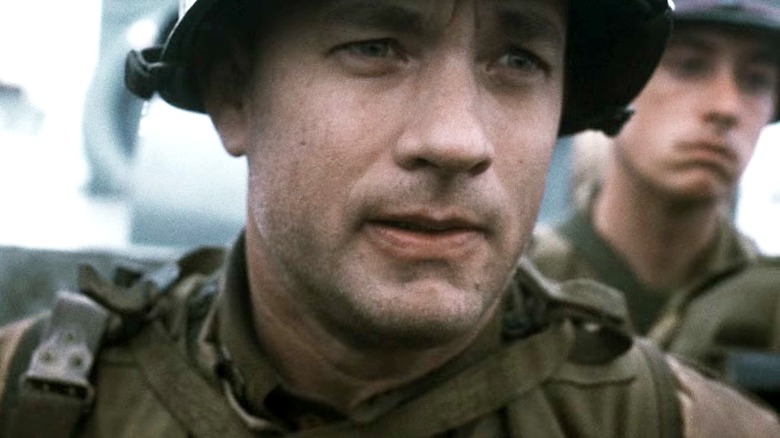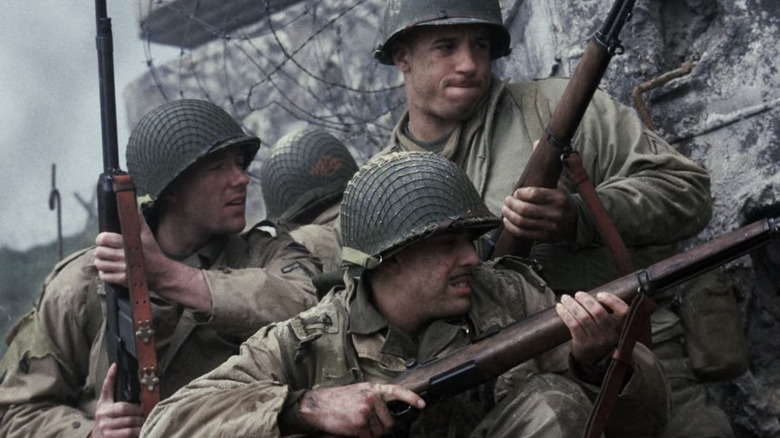The Impressive Story Of How Saving Private Ryan's D-Day Sequence Was Shot
"Saving Private Ryan" earned Steven Spielberg his second Academy Award for best director, and deservedly so. It's one of the greatest war movies of all time. Even those who weren't enamored of the overall film back in 1998 had to concede that its depiction of the D-Day landing on Omaha Beach in Normandy during World War II was an impressive technical feat.
Given the visceral impact of that sequence, you might be surprised to learn that Spielberg did not storyboard it or plan out elaborate shot lists for it beforehand. He also won the DGA (Director's Guild of America) Award for "Saving Private Ryan," and years later an issue of DGA Quarterly (via Game Rant) revealed that the D-Day sequence only took up seven pages of Robert Rodat's script. Yet Spielberg stretched it out to a 25-minute battle scene, full of memorable deaths, like the soldier whose helmet blocks a bullet, only for him to take the helmet off and receive another bullet right between the eyes.
Here's how Spielberg himself described the D-Day scene's planning:
"I had to shoot this sequence one step at a time because that's the way the Rangers took the beach: one inch at a time. As a result, I was able to make up this whole sequence as I went along. I don't mean the whole history or the narrative of what happened on June 6, 1944, but literally to come up with shots on the spur of the moment and not a month ahead of time. It helped make things a little more chaotic and unpredictable."
Cinematography and Sound Design
Janusz Kaminski also won an Oscar for Best Cinematography for "Saving Private Ryan," and he and Spielberg referenced the "blurred look of 1940s photographs and newsreels" for the D-Day sequence. To achieve a war documentary aesthetic, they shot it primarily with handheld cameras. Spielberg also said that he "drained 60 percent of the color out of the movie."
"I didn't want a Hollywood war movie in Technicolor," he said. "Desaturation was the easiest way of taking the bloom off the rose."
You might think that shooting handheld is what gives the D-Day scene such a shaky-cam aspect, and that's part of it; but Spielberg also used a lens called the Image Shaker. Before he found that lens, he tried taping a Black & Decker drill to the camera so that he could vibrate the image at will simply by turning on the drill.
Gary Rydstrom's sound design also played a crucial part in the D-Day sequence, taking the viewer in and out of the noisy battle by plunging them underwater and having Captain Miller (Tom Hanks) lose his hearing at one point when his ears are left ringing by a mortar explosion. Amid the sounds of war, Spielberg kept the camera moving at all times and sought to ensure through editing that the film would not linger on any one shot too long. He explained:
"I didn't want to show the audience too much all at once. I didn't want any one shot held on the screen for too long. I wanted them to be able to see things in increments, so that the impression was a large composite of horror and carnage, but the pieces would add up to good effect by the end of the 25 minutes."
With the D-Day sequence in "Saving Private Ryan," Steven Spielberg and company not only achieved the impression he wanted; they outdid themselves and left us with one of the most gripping battle scenes ever put to celluloid.

